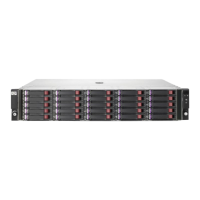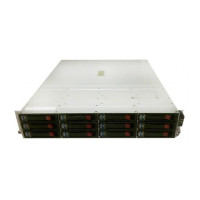FC switch requirements
For additional B-series and C-series FC switches, local and remote MPX200 Multifunction Router pairs
must be connected to the same Fibre Channel switch product line series.
NOTE:
The MPX200 Fibre Channel ports operate at 2, 4, and 8 Gb/s.
IP network requirements
HP requires that the following standards be met for the IP network:
• Supported network protocols are TCP/IP IPv4 and IPv6 Ethernet 1,000 Mb/s.
See EVA storage system rules and guidelines, page 113 for minimum IP bandwidth requirements.
• For MPX200 IP data—Local and remote pairs are supported for up to 100 ms of IP network delay
one-way, or 200 ms round-trip for HP Continuous Access EVA. HP requires dedicated IP bandwidth
(see Table 14).
• For MPX200 IP management—LAN and WAN are supported.
Table 14 Network requirements for the MPX200 with XCS and VCS
DescriptionSpecification
Must be dedicated to the HP Continuous Access storage replica-
tion Bandwidth function. There is no support for dynamic pacing
of the gateway.
Bandwidth
1
See Table 13 for minimum supported bandwidth based on the
average maximum number of DR groups packet-loss ratio and
one-way intersite latencies.
Maximum number of DR groups
1,500 bytesMTU of the IP network
EVA: 100 ms one-way or 200 ms round-trip
Maximum latency
1
Low-loss network: 0.0012% average over 24 hours
High-loss network: 0.2% average over 24 hours; must not exceed
0.5% for more than 5 minutes in a 2-hour window
Average packet-loss ratio
2
Must not exceed 10 ms over 24 hours.
Latency jitter
3
1
Pre-existing restriction
2
A high packet-loss ratio indicates the need to retransmit data across the intersite link. Each retransmission
delays transmissions queued behind the current packet, thus increasing the time to complete pending
transactions.
3
Latency jitter is the difference between the minimum and maximum values, and indicates how stable or
predictable the network delay. The greater the jitter, the greater the variance in the delay, which lowers the
performance predictability.
MPX200 FCIP114
